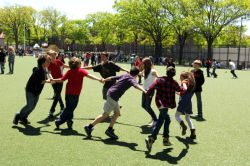Washington Park
J.J. Byrne Park
James J. Byrne was born April 8, 1863 on Water Street in Brooklyn to Irish immigrant parents. He was raised near the Brooklyn Navy Yard in an area known as Irishtown. He completed St. James parochial school with an eighth grade diploma, and worked in the machinist trade. He joined the Building Department as a clerk in 1898.
He was appointed chief clerk of the Bureau of Public Buildings (1907-08) and later Brooklyn Commissioner of Public Works (1924-26). When Borough President Joseph A. Guider died in office in September 1926, Byrne was selected to complete the term. He was elected in 1929. Byrne died in office on March 14, 1930, after a period of declining health. His wife’s brother-in-law was John H. McCooey, Democratic Leader of Kings County. Projects developed during Byrne’s tenure included the Brooklyn Municipal Building, completed in 1926, the Central Court Building in Brooklyn Heights, completed in 1932, extensive sewer system additions, and expansion of the public library. J.J. Byrne Park was acquired by Parks in 1926 and was named for Byrne by the Board of Aldermen in 1933. The Old Stone House of Gowanus, located at the rear of the park, is the reconstruction of the Vechte-Cortelyou house, originally built by Claes Arents Vechte in 1699. Though the building was demolished around 1897, its foundations were rediscovered in 1930, at which time Borough President Byrne ordered its reconstruction from the original brick. It was completed in 1934 as a park office and public restroom.
The house entered the annals of American Revolutionary history on August 27, 1776 in the Battle of Long Island. A company of Maryland soldiers, known as the Maryland 400, under the command of Lord Stirling (also known as General William Alexander) held off British General Cornwallis’ troops, who had captured the Old Stone House, to allow General George Washington and his forces time to escape across Gowanus Creek. The mission was a success, though at a cost of 250 lives. The bravery of the Maryland 400 is honored by a monument designed by Stanford White and unveiled in 1895 on Lookout Hill in Prospect Park. Over the next century, the house was owned by prominent Brooklynites. The Cortelyou family purchased the home and farm in 1790. Edwin C. Litchfield bought the home in 1850 as a real estate investment. In later years the house served as the clubhouse of the Bridegrooms, the baseball team that preceded the Dodgers.
In 1951 Byrne Park was joined with the newly constructed William Alexander Junior High School 51 and its adjacent jointly operated playground. A capital project was completed in 1996 which entailed full-scale reconstruction of the Old Stone House, including new roofing, windows, and finishing as well as new mechanical, plumbing, and electrical systems.
Check out your park's Vital Signs
Clean & Safe
Green & Resilient
Empowered & Engaged Users
Share your feedback or learn more about how this park is part of a
Vital Park System

